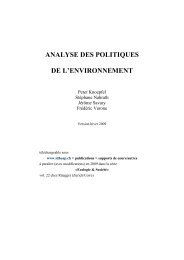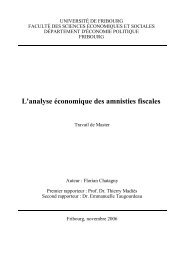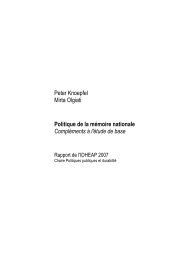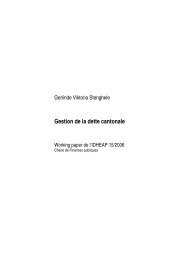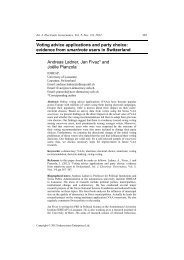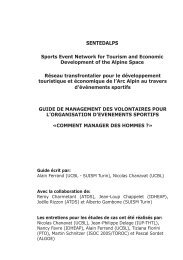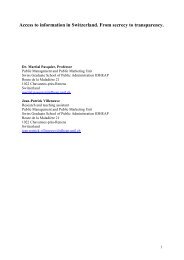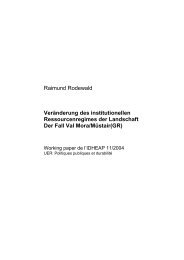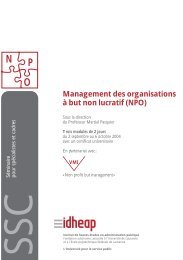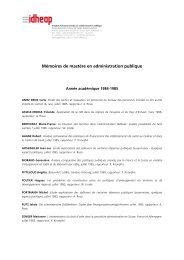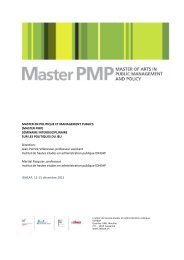Historical Analysis of Institutional Regimes in Switzerland ... - IDHEAP
Historical Analysis of Institutional Regimes in Switzerland ... - IDHEAP
Historical Analysis of Institutional Regimes in Switzerland ... - IDHEAP
You also want an ePaper? Increase the reach of your titles
YUMPU automatically turns print PDFs into web optimized ePapers that Google loves.
18<br />
that jurisdiction lies with the cantons (Article 76 Paragraph 4 Swiss Federal Constitution). This is not<br />
based on a private legal concept <strong>of</strong> property but on the constitutional allocation and def<strong>in</strong>ition <strong>in</strong><br />
accordance with Article 664 <strong>of</strong> the Swiss Civil Code, whereby there is no private ownership <strong>of</strong><br />
public water bodies. In cases where the jurisdiction for water bodies <strong>of</strong> the common good is applied,<br />
private <strong>in</strong>dividuals are excluded from use <strong>of</strong> the waters. In this <strong>in</strong>stance it the obligation <strong>of</strong> the cantons<br />
to authorise private legal positions and water uses, where applicable (Article 664, Paragraph. 3<br />
Swiss Civil Code), and this has occurred <strong>in</strong> some cases. Otherwise, rights to the public water bodies<br />
arise through concessions which allow acquired rights to water use to emerge which can only be<br />
resc<strong>in</strong>ded through expropriation.<br />
Policy design: Initial <strong>in</strong>vestigations (Leimbacher/Perler 2000) show that there were no significant<br />
changes to property rights to water dur<strong>in</strong>g the 20th century. In contrast, significant developments<br />
were observed with respect to public policies and these took place <strong>in</strong> three ma<strong>in</strong> phases.<br />
Policies regulat<strong>in</strong>g protection aga<strong>in</strong>st water (river corrections, alluvial valleys dra<strong>in</strong>age, mounta<strong>in</strong><br />
torrent corrections) were created at the turn <strong>of</strong> the century. The major river correction projects <strong>of</strong><br />
the 19th and 20th centuries were ma<strong>in</strong>ly concerned with the protection <strong>of</strong> people, the land and other<br />
goods. Hydraulic eng<strong>in</strong>eer<strong>in</strong>g structures were ma<strong>in</strong>ly <strong>in</strong>tend to provide protection aga<strong>in</strong>st mounta<strong>in</strong><br />
torrents, erosion and landslides and this was the motivation beh<strong>in</strong>d the comb<strong>in</strong>ation <strong>of</strong> hydraulic<br />
eng<strong>in</strong>eer<strong>in</strong>g and forest police concerns <strong>in</strong> the mounta<strong>in</strong> regions (Federal Law on the Hydraulic<br />
Eng<strong>in</strong>eer<strong>in</strong>g Police <strong>of</strong> 1877; WBPG based on Article 24 Swiss Federal Constitution <strong>of</strong> 1874).<br />
Water use policies (particularly concern<strong>in</strong>g energy production) <strong>in</strong>creased dur<strong>in</strong>g the first part <strong>of</strong> the<br />
century. The use <strong>of</strong> water heat from surface and underground lakes and rivers by means <strong>of</strong> heat<br />
pump<strong>in</strong>g systems and the use <strong>of</strong> water for the production <strong>of</strong> hydro-electric power resulted <strong>in</strong> the<br />
award<strong>in</strong>g <strong>of</strong> concessions (Federal Law on the Use <strong>of</strong> Water Power <strong>of</strong> 1916; WRG based on Article<br />
24 bis <strong>of</strong> the Federal Swiss Constitution <strong>of</strong> 1908).<br />
F<strong>in</strong>ally, the period from the 1950s saw the development <strong>of</strong> water protection policies (both<br />
qualitative and quantitative) (Article 24 quater on protection <strong>of</strong> waters <strong>of</strong> 1953). Increas<strong>in</strong>g population<br />
density, <strong>in</strong>dustrialisation and economic expansion meant that water suddenly needed protection. The<br />
aim <strong>of</strong> the redef<strong>in</strong>ition <strong>of</strong> Article 24 bis <strong>of</strong> the Federal Swiss Constitution <strong>of</strong> 1975 - as the last step at<br />
constitutional level - was the co-ord<strong>in</strong>ation <strong>of</strong> all efforts and the record<strong>in</strong>g <strong>of</strong> the entire water cycle:<br />
household use, protection <strong>of</strong> water sources and prevention <strong>of</strong> damag<strong>in</strong>g effects to water. Various<br />
federal acts and the practice <strong>of</strong> the federal courts also made provision for the co-ord<strong>in</strong>ation <strong>of</strong> the<br />
different aims: for example, an environmental impact study for larger hydro-electric power systems or<br />
hydraulic structures, for cases <strong>in</strong>volv<strong>in</strong>g concrete <strong>in</strong>tervention <strong>in</strong> the ecological system or for the<br />
award<strong>in</strong>g <strong>of</strong> concessions for use <strong>of</strong> water with a number <strong>of</strong> exceptional and additional authorisations.<br />
The qualitative and quantitative water protection acts were <strong>in</strong>cluded <strong>in</strong> the revision <strong>in</strong> 1991 <strong>of</strong> the<br />
older water protection acts (GSchG) <strong>of</strong> 1955 and 1971 (<strong>in</strong>troduction <strong>of</strong> regulations on residual<br />
water volumes <strong>in</strong> addition to the exist<strong>in</strong>g care and redevelopment obligations, sewage treatment<br />
plants, limit values for toxic substances etc.). In 1996, a “Landscape Centime/Franc” was also<br />
<strong>in</strong>troduced as a new <strong>in</strong>strument <strong>of</strong> water use legislation for the direct f<strong>in</strong>anc<strong>in</strong>g <strong>of</strong> landscape<br />
protection (Revision <strong>of</strong> the Water Power Act <strong>of</strong> 1916: new Article 49). F<strong>in</strong>ally, the Protection <strong>of</strong><br />
Waters Decree <strong>of</strong> 1998 formulates ecological aims for water bodies and makes provision for the<br />
implementation <strong>of</strong> plann<strong>in</strong>g <strong>in</strong>struments (water protection areas, water protection measures, ground<br />
water protection areas for dr<strong>in</strong>k<strong>in</strong>g and service water) as well as specific measures (e.g. fertiliser use<br />
that is compatible with protection <strong>of</strong> waters).



